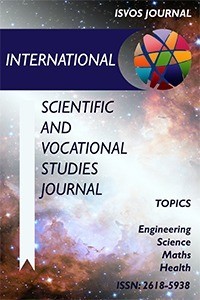Structural Electronic and Dynamic Properties of Li3Pb
In this study, the structural, electronic and dynamic properties of Li3Pb compound were examined by using Density Functional Theory within the Generalized Gradient Approximation. The lattice constant and the bulk modulus were calculated and compared with the experimental and theoretical results in the literature and the calculations were found to be consistent. The energy band and the total density of state diagrams of the Li3Pb compound were generated and it was seen that Li3Pb compound shows a metallic property. The values of the acoustic and the optical modes of the transverse and longitudinal branches at Γ, X, L, K, W and U high symmetry points were calculated and the phonon distribution curve was plotted against these high symmetry points. These calculations were not previously performed in the literature. It is thought that these calculations will shed light on the studies that will take place in the future.
Anahtar Kelimeler:
Li3Pb, Structural Properties, Dynamic Properties, Electronic Properties, Density Functional Theory
Structural Electronic and Dynamic Properties of Li3Pb
In this study, the structural, electronic and dynamic properties of Li3Pb compound were examined by using Density Functional Theory within the Generalized Gradient Approximation. The lattice constant and the bulk modulus were calculated and compared with the experimental and theoretical results in the literature and the calculations were found to be consistent. The energy band and the total density of state diagrams of the Li3Pb compound were generated and it was seen that Li3Pb compound shows a metallic property. The values of the acoustic and the optical modes of the transverse and longitudinal branches at Γ, X, L, K, W and U high symmetry points were calculated and the phonon distribution curve was plotted against these high symmetry points. These calculations were not previously performed in the literature. It is thought that these calculations will shed light on the studies that will take place in the future.
Keywords:
Li3Pb, Structural Properties, Dynamic Properties, Electronic Properties, Density Functional Theory,
___
- [1] Y. M. Sun, X. L. Hu, W. Lou, and Y. H. Huang, “Ultrafine MoO 2 nanoparticles embedded in a carbon matrix as a high-capacity and long-life anode for lithium-ion batteries”, Journal of Material Chemistry, 22, pp. 425-431, 2012.
- [2] S. W. Ko, J. J. Lee, H. S. Yang, S. J. Park, and U. Jeong, “Mesoporous CuO particles threaded with CNTs for high‐performance lithium‐ion battery anodes”, Advanced Materials, 24, pp. 4451-4456, 2012.
- [3] S. A. Needham, G. X. Wang, and H. K. Liu,” Synthesis of NiO nanotubes for use as negative electrodes in lithium ion batteries”, Journal of Power Sources, 159, pp. 254-257, 2006.
- [4] Y, İşler, “Performance Analysis of Storage, Grid Connected Hybrid Photovoltaic System,” International Scientific and Vocational Studies Journal , 2 (2) , 118-124, 2018.
- [5] J. O. Besenhard, J. Yang, and M. Winter,” Will advanced lithium-alloy anodes have a chance in lithium-ion batteries?”, Journal Power Sources, 68(1), pp. 87-90, 1997.
- [6] M. Martos, J. Morales, and L. Sanchez,” Lead-based systems as suitable anode materials for Li-ion batteries”, Electrochimica Acta, 48, pp. 615-621, 2003.
- [7] A. Zalkin, and W. J. Ramsey, “Intermetallic Compounds between Lithium and Lead. I. The Structures of Li3Pb and Li7Pb2”., The Journal of Physical Chemistry, 60, pp. 234-236, 1956.
- [8] N. F. M. Henry, and K. Lonsdale, “International tables for X- ray crystallogrophy”, by The Kynoch Press, Birminghan, England, 1952.
- [9] S. M. Wood, and Ph.D. Thesis, “Studies of Potential Anode Materials for Lithium–Ion Batteries”, The University of Texas at Austin, 2016.
- [10] D. Wang, K. Wu, L. Ren, J. Shou, J. Shui, R. Ma, X. Lin, N. Long, Y. Ren, and J. Shu, “Facile fabrication of Pb (NO3) 2/C as advanced anode material and its lithium storage mechanism”, Electrochimica Acta, 120, pp. 110-121, 2014.
- [11] S. Terlicka, A. Dębski, and W. Gąsior, “Thermodynamic properties of Li-Pb system”, Journal of Molecular Liquids, 249, pp. 66-72, 2018.
- [12] C. Zhou, C. Guo, C. Li, and Z. Du, “Thermodynamic optimization of the Li–Pb system aided by first-principles calculations”, Journal of Nuclear Materials, 477, 2016 pp. 95-101, 2016.
- [13] S. Baroni, A. D. Corso, S. de Gironcoli, P. Giannozzi, C. Cavazzoni, G. Ballabio, S. Scandolo, G. Chiarotti, P. Focher, A. Pasquarello, K. Laasonen, A. Trave, R. Car, N. Marzari, and A. Kokalj, Quantum Espresso package, 2005. www.quantum-espresso.org/
- [14] P. J. Perdew, K. Burke, and M. Ernzerhof, “Generalized Gradient Approximation Made Simple”, Physical Review Letters, 77, pp. 3865-3868, 1996.
- [15] H. J. Monkhorst, and J. D. Pack, “Special points for Brillouin-zone integrations”, Physical Review B, 13, pp. 5188-5192, 1976.
- [16] W. Kohn, and L. J. Sham, “Self-consistent equations including exchange and correlation effects”, Physical Review, 140, pp. 1133-1138, 1965.
- [17] A. Kokalj, “XCrySDen—a new program for displaying crystalline structures and electron densities”, Journal of Molecular Graphics and Modelling, 17, pp. 176-179, 1999.
- ISSN: 2618-5938
- Yayın Aralığı: Yılda 2 Sayı
- Başlangıç: 2017
- Yayıncı: Umut SARAY
Sayıdaki Diğer Makaleler
The Importance of Creativity in Space Design
Effect of Active Filler Ratio on Indirect Tensile Strenght of Foam Bituminous Mixtures
Kemal Muhammet ERTEN, Serdal TERZİ, Hüseyin AKBULUT
Changes in Crop and Irrigation Water Requirements in Niğde
Structural Electronic and Dynamic Properties of Li3Pb
Sinem ERDEN GÜLEBAĞLAN, Emel KİLİT DOGAN
Knowledge and Applications of Women on Iodine Salt Use
Özgür ALPARSLAN, Rıza ÇITIL, Gizem ÇITAK
ANN: Prediction of Heat Transfer and Flow Characteristics of a Tube with Modified Twisted Tapes
Aslı DURMUŞOĞLU, Sibel GÜNEŞ, Emrah ÖZAŞIR
A Tabu Search Algorithm for an Excavator Scheduling Problem
Energy Sector Analysis with Fuzzy TOPSIS
